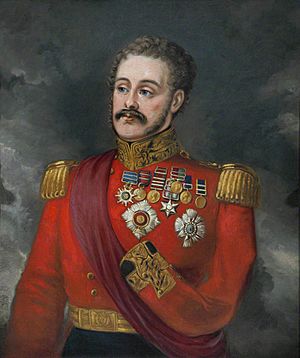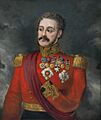Joseph Thackwell facts for kids
Quick facts for kids
Sir
Joseph Thackwell
GCB KH
|
|
|---|---|

Sir Joseph Thackwell, by Thomas Harrington Wilson, c.1846
|
|
| Born | 1 February 1781 |
| Died | 8 April 1859 (aged 78) |
| Allegiance | United Kingdom |
| British Army | |
| Rank | Lieutenant-General |
| Commands held | 15th Hussars |
| Battles/wars |
|
Lieutenant-General Sir Joseph Thackwell (1781–1859) was a brave officer in the British Army. He fought in many important wars and battles. He served with the 15th Hussars during the Peninsular War in Spain and Portugal. He was at the Battle of Sahagún in 1808 and the Battle of Vitoria in 1813. Sir Joseph also fought at the famous Battle of Waterloo in 1815, where he lost his left arm.
Later, he commanded his regiment for many years. He then served in India, leading cavalry forces in the First Anglo-Afghan War (1838–1839). He also fought in the First Anglo-Sikh War (1845–1846) at the Battle of Sobraon. In the Second Anglo-Sikh War (1848–1849), he was at the Battle of Chillianwala and the Battle of Gujrat. Sir Joseph was a highly respected military leader.
Contents
Becoming a Soldier
Joseph Thackwell was born on February 1, 1781. He was the fourth son of John Thackwell, a local judge. In 1798, when he was 17, Joseph joined the Worcester Fencible Cavalry. He started as a "cornet," which was a junior officer rank. He was promoted to lieutenant in 1799. He served in Ireland until his regiment was disbanded in 1800.
Serving with the 15th Hussars
In April 1800, Joseph Thackwell bought a position in the 15th (The King's) Light Dragoons. This meant he paid money to become an officer. He became a lieutenant in June 1801. After a peace treaty in 1802, he was put on "half-pay," meaning he got less money because he wasn't actively serving. But he returned to his regiment in 1804.
His regiment became "hussars" in 1806. Hussars were a type of light cavalry known for their fancy uniforms and daring charges. Thackwell became a captain in April 1807.
Fighting in the Peninsular War
In 1808, the 15th Hussars went to the Peninsular War in Spain. They played a big part in the Battle of Sahagún on December 21, 1808. They also helped protect General Sir John Moore's army as it retreated.
After some time back in England, the regiment returned to Spain in 1813. They joined a cavalry group led by General Graham. On May 31, 1813, Thackwell led his squadron across the Esla River. They surprised a French cavalry group and captured thirty prisoners.
He fought in the Battle of Vitoria on June 21, 1813, and helped chase the enemy. He was also at the Battle of the Pyrenees and the Siege of Pamplona. He took part in the battles of Orthez, Tarbes, and Toulouse. For his bravery, he received the Peninsular Medal with two clasps, which were special awards for his service.
The Battle of Waterloo
In 1815, Thackwell and the 15th Hussars fought in the famous Battle of Waterloo. His brigade was on the right side of the British battle line. He later wrote about his experiences there. His regiment bravely charged French cavalry and infantry squares. During the battle, two of his horses were shot from under him. He was also badly wounded in his left arm. The next day, his arm had to be removed.
After Waterloo, he was promoted to major. In 1817, he became a lieutenant-colonel. He took command of the 15th Hussars in June 1820. After serving for nearly 32 years in the regiment, he left in 1832. In 1834, he was made a Knight of the Royal Guelphic Order, another important honor.
Service in India
In January 1837, Thackwell became a colonel in the army. In May 1837, he took command of the 3rd The King's Own Dragoons. He traveled with his new regiment to India, arriving in November 1837.
Leading Cavalry in Wars
He became a major-general in India and led the cavalry for the Army of the Indus. This army fought in the First Anglo-Afghan War (1838–1839). He was present at the Siege of Ghazni. He also commanded a column of the army returning to India from Kabul. For his service, he received important awards: he became a Commander of the Order of the Bath (CB) in 1838 and a Knight Commander of the Bath (KCB) in 1839.
In 1843, he led the cavalry division of Sir Hugh Gough's army in a short campaign against the Marathas in Gwalior. He was praised for his actions at the Battle of Maharajpur.
First Anglo-Sikh War
In the First Anglo-Sikh War, he again commanded the cavalry at the Battle of Sobraon on February 10, 1846. He led his cavalry over enemy defenses, a task usually done by infantry. This showed his great courage. He was promoted to major-general in November 1846.
Second Anglo-Sikh War
When the Second Anglo-Sikh War began, Thackwell was first given command of an infantry division. But after another officer died, he was moved back to lead the cavalry division.
At the Battle of Chillianwala on January 13, 1849, Thackwell commanded the cavalry on the left side of the British forces. His cavalry helped keep the enemy in check.
At the Battle of Gujrat on February 21, 1849, Thackwell was again on the left flank. He stopped the enemy cavalry from attacking the British side. After the battle was won, he led a strong chase of the retreating enemy until nightfall. General Gough praised him highly for his "valuable assistance and untiring exertions."
For his bravery and leadership, Thackwell received thanks from the British Parliament three times. He was also given the highest honor, the Knight Grand Cross of the Order of the Bath (GCB), on June 5, 1849.
Later Life and Family
In November 1849, Sir Joseph Thackwell was given the role of colonel of the 16th Lancers. From 1854 to 1855, he was the Inspector-General of Cavalry, overseeing all cavalry forces. He was promoted to lieutenant-general in June 1854.
Sir Joseph married Maria Audriah Roche in 1825. They had four sons and three daughters. He bought a home called Aghada Hall in County Cork, Ireland, in 1853. He passed away there in April 1859.
His four sons also became officers in the British Army. His second son, William de Wilton Roche Thackwell, became a major-general. His third son, Osbert Dabitôt Thackwell, was killed in India in 1858 during a rebellion. His fourth son, Francis John Roche Thackwell, died in India in 1869 from wounds caused by a tiger. Sir Joseph's nephew, Joseph Edwin Thackwell, also became a lieutenant-general and served as his uncle's aide in India.
In 1908, a book about his life, The Military Memoirs of Lieut.-General Sir Joseph Thackwell, was published. Today, a portrait of him can be seen at the National Army Museum in London.
Images for kids


